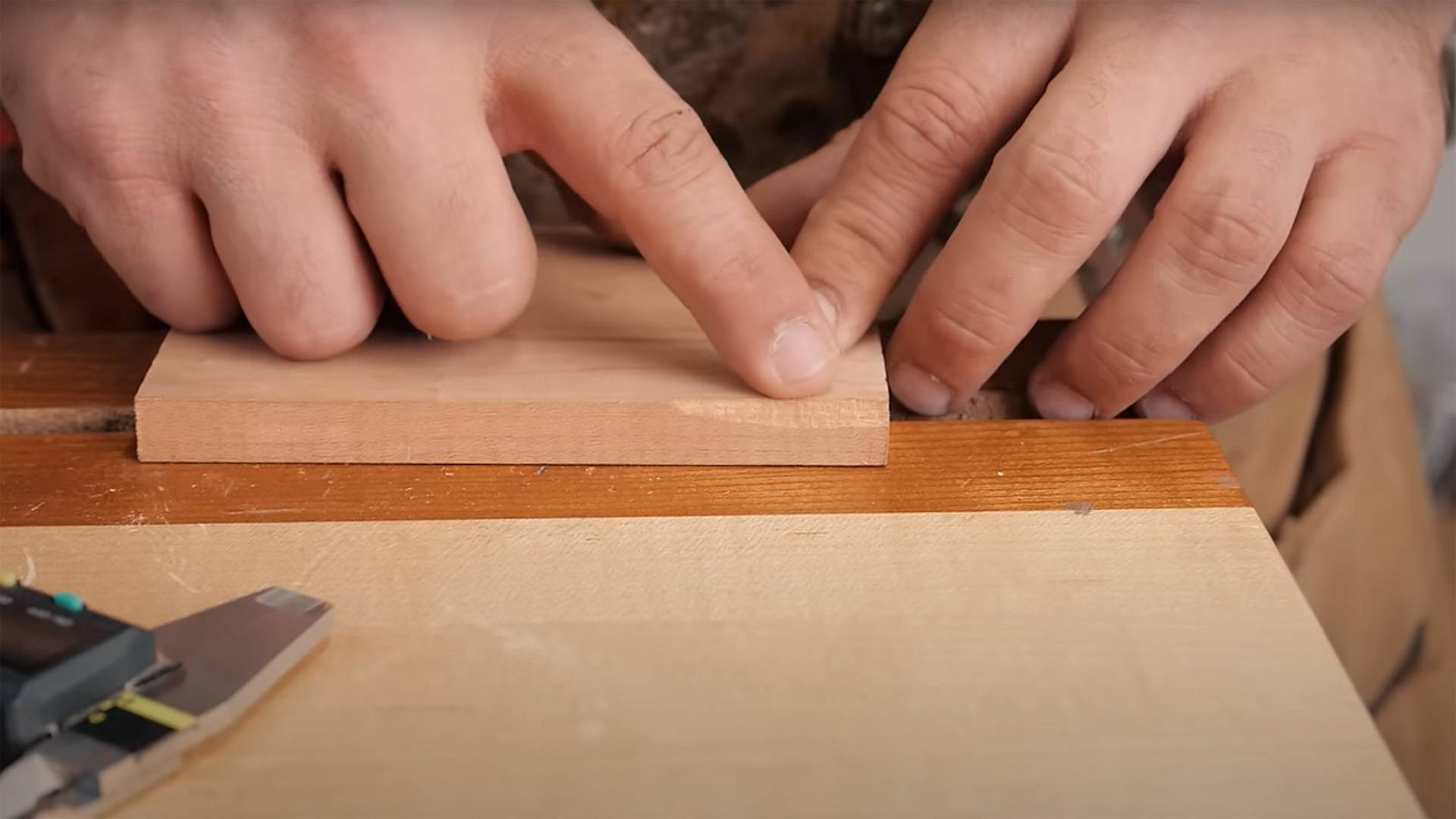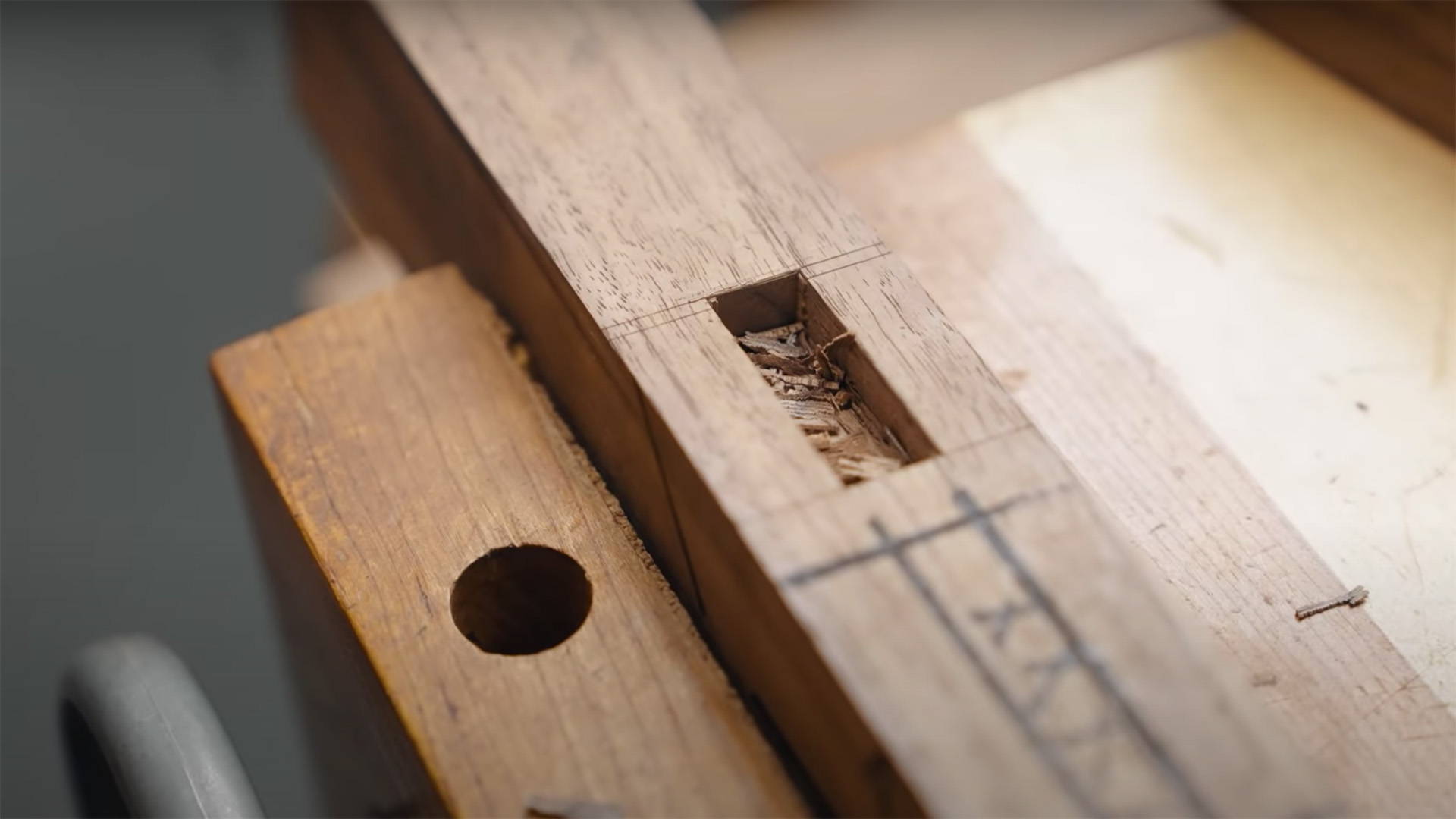It’s one of the biggest frustrations in woodworking.
You have a beautiful, flat board ready to use in one of your projects…
But when you grab it to finally start cutting some joinery — it’s cupped like a half-pipe from Tony Hawk Pro Skater.
Don’t worry. There’s no need to get your Tech Deck.
Because today, I’m sharing 5 tricks to avoid cupped boards all together — or flatten them if all else fails.
WHY DO BOARDS CUP?
Boards usually cup for two main reasons:
MOISTURE
Lumber is always trying to match the humidity of the air around it.
As it absorbs moisture, it swells. And as it releases moisture, it shrinks. A lot like the stinky sponge at the bottom of your sink (just replace the damn thing).
It’s a normal phenomenon called wood movement. But the problem is when it happens unevenly.
If one face of a board is drier than the other, it’ll shrink as the side with more moisture expands.
This leads to a concave cup forming on the drier face.
A common cause of this is leaving boards on a flat surface like your workbench.
The top face has plenty of air circulation, which dries it out. But the bottom face on the workbench doesn’t — so it locks in moisture.
Leave it like that for long enough and you’ll end up with a cupped board.
INTERNAL TENSION
When you cut or mill boards, you can release internal tension — like a spring under pressure.
This is especially apparent when resawing boards in half.
Sometimes you’ll resaw a board, and the two sides will IMMEDIATELY cup on the freshly exposed faces.
That’s thanks to the tension inside the board.
So how can you deal with this? There are a few ways.
1. STORE LUMBER ON CAULS
The best way to store lumber is to stack it on cauls.
Cauls are just flat pieces of wood or metal of the same thickness. And their secret is airflow.
If you stack boards on the floor or directly on top of each other, you block the airflow to one of the faces.
That means the face that is exposed to the air will dry out faster — resulting in a cup.
Place a few cauls between the floor and a board, plus a few between each board as you stack them.
This allows even airflow all around the boards, resulting in even moisture.
Given enough time, this could even help with boards that are already cupped.
2. MILL BOTH FACES BEFORE RESAWING
Resawing a board exposes fresh inside faces, which have a lot of locked-in moisture.
And if the outside faces are dry, the two halves will cup pretty intensely overnight.
Mitigate this by taking material off both faces before resawing.
This exposes higher-moisture wood that won't be as different as the fresh inside faces.
And if stacked on cauls (and maybe with some weight on top), they should stabilize flat.
3. RESAW BOARDS THICKER THAN YOU NEED
Resawn boards are pretty much guaranteed to cup (even with the tips outlined here).
So it’s best to just plan for it and resaw boards that are thicker than you need.
Once they stabilize, you can remill them flat.
4. CLAMP RESAWN BOARDS TOGETHER
This trick is dead simple and can work surprisingly well.
After you resaw a board, place the two original outside faces against each other.
Then clamp their edges together so they’re nice and flat. Leave the boards like this for a day or two.
In theory, this should offset the internal tension and moisture imbalances.
And if you’re lucky, the boards will stay flat when you remove the clamps.
5. RESAW WITH RIFT OR QUARTER SAWN LUMBER
There are 3 main lumber types: flat sawn, rift sawn, and quarter sawn.
Flat sawn is far and away the cheapest — but also the most susceptible to cupping.
If you have the budget, do your resawing with rift and quarter sawn lumber.
The orientation of the growth rings makes them pretty resistant to warping.
But if flat sawn lumber is your only option, use the other tips listed here.
TIP: Flat sawn lumber cups the opposite way that the growth rings curve (i.e. the rings want to "flatten" out). Keep this in mind when building your projects.
6. WET DOWN THE DRY SIDE
If a board’s been sitting around and is cupped, there IS a way to help flatten it out.
It’s not a sure-fire solution for longterm flatness — but it can at least help you get boards flat while you cut joinery (assembly, glue up, and clamps can hold them flat later on).
Start by wetting down the cupped (concave) side of the board. Remember, this side shrunk because it’s drier.
You don’t need to soak it. Just apply a thin, even layer of water all over the surface.
Now set the board on a flat surface with the cupped and wet side facing DOWN.
It’s also good to have air circulation, so turn on a fan if you can.
As the air dries out the top, the board should start to flatten out — sometimes even in just a couple hours.
Add some weight to the top if it’s not working. But be careful to not overcorrect (yes, this technique can cup your board the opposite way).
7. DRY OUT THE WET SIDE
This is basically the exact opposite of the tip above.
Instead of wetting down the dry concave side of the board, the aim is to dry out the side with more moisture.
And the easiest way to do it? Solar power.
Lay down some cauls in the sun in your driveway or yard. Then lay the board on top with the moist, convex side facing up.
Check in every so often with a square to monitor the progress.
After some time, the board should flatten itself out.
LEARN TO CONTROL THE CUP
Cupped boards and panels can seem unavoidable — or even like a major catastrophe.
But with the tips above, you’ll have no problem mitigating cups…
Or even doing away with them after the fact.
Want to learn how to resaw boards to maximize lumber and make wild grain wraps? Read this.
Any other tips for dealing with cupped boards? Let us know in the comments below!
Follow us on Instagram @katzmosestools, on TikTok @katzmoseswoodworking, and check out my YouTube channel for more great woodworking content...
And as always, STAY SAFE IN THE SHOP!











5 comments
Roger
My lumber is stored in a cold Minnesota shed, so cupping has been an issue for a long time. Thank you for the tips!! By the way, I built your kids’ Kitchen Helper (hinged to convert from a stand-up stool to a table) using your pattern and instructions and it turned out perfect! Gets used all of the time! Thank you for this!
My lumber is stored in a cold Minnesota shed, so cupping has been an issue for a long time. Thank you for the tips!! By the way, I built your kids’ Kitchen Helper (hinged to convert from a stand-up stool to a table) using your pattern and instructions and it turned out perfect! Gets used all of the time! Thank you for this!
Brian
Great tips but I was hoping for one more, I think. I am a beginner woodworker and always wondered about the grooves on the backside of finish wood like door casing and baseboard trim. The grooves always seem to be different sizes. How do you determine the size/quantity of grooves and their depth to avoid cupping if that is what they are for. I would like to create my own door casings and baseboard trim as the quality of wood in the big box stores is not what it was 30 to 40 years ago.
Great tips but I was hoping for one more, I think. I am a beginner woodworker and always wondered about the grooves on the backside of finish wood like door casing and baseboard trim. The grooves always seem to be different sizes. How do you determine the size/quantity of grooves and their depth to avoid cupping if that is what they are for. I would like to create my own door casings and baseboard trim as the quality of wood in the big box stores is not what it was 30 to 40 years ago.
Gary P Miller
Thank you for the tips, Jonanthan. I appreciate them.
Gary P Miller
Thank you for the tips, Jonanthan. I appreciate them.
Gary P Miller
Vic
I have solid wood kitchen cabinet doors that are original to my 1955 era house that I want to refinish. They’re panel construction and some are slightly warped. The worst one is a 24” x 30” door that has about 1/2” of warpage at one corner. Do you have a good process for fixing this?
I have solid wood kitchen cabinet doors that are original to my 1955 era house that I want to refinish. They’re panel construction and some are slightly warped. The worst one is a 24” x 30” door that has about 1/2” of warpage at one corner. Do you have a good process for fixing this?
John
I had a problem with a cupped price of walnut. I ripped the section I wanted into about half inch strips. If you look at the stripes from the ends you’ll see that they are actually cut at an angle because of the cupping, however tension is relieved I think, the strips fit back together. Glue em up, plane it and it’s flat. More work? Perhaps. But it’s flat.
I had a problem with a cupped price of walnut. I ripped the section I wanted into about half inch strips. If you look at the stripes from the ends you’ll see that they are actually cut at an angle because of the cupping, however tension is relieved I think, the strips fit back together. Glue em up, plane it and it’s flat. More work? Perhaps. But it’s flat.